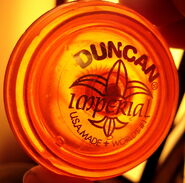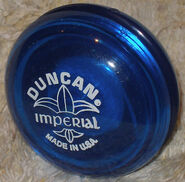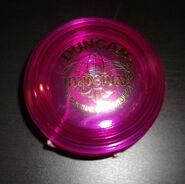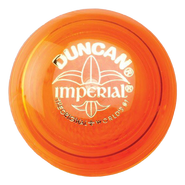(Undo revision (remove grafitti) 27127 by 122.60.140.155 (talk)) |
(Adding categories) |
||
| (27 intermediate revisions by 5 users not shown) | |||
| Line 1: | Line 1: | ||
| + | {{Infobox Yo-Yo New |
||
| − | The '''Imperial''' is one of the most common [[Duncan]] yo-yos produced. Featuring a simple plastic body construction with a metal axle, the yo-yo has a narrow gap. |
||
| + | |title1=Imperial |
||
| + | |image1=DuncanImperial4Infobox.jpg |
||
| + | |caption1= |
||
| + | |manufacturer=[[Duncan]] |
||
| + | |release_date=1954 |
||
| + | |shelf_status=Available |
||
| + | |shape=Imperial |
||
| + | |color(s)=Various |
||
| + | |weight=51.7 grams |
||
| + | |dimensions=Diameter: 57.33 <br> Width: 34.24mm |
||
| + | |material=Plastic |
||
| + | |bearing=Fixed steel axle |
||
| + | |response_system=Starburst |
||
| + | }}The '''Imperial''' is one of [[Duncan]]'s two most iconic and best-selling yo-yos, alongside the [[Duncan Butterfly|Butterfly]]. It was first released in 1954, and has been a true classic since its introduction back then, and it is still in production to this day. It was even licensed for [[Bandai]]'s ''Hyper Yo-Yo'' range in 1997 as the '''Hyper Imperial''' (Japanese: '''ハイパーインペリアル'''). |
||
| + | The Imperial is a plastic looping yo-yo with a fixed metal axle, starburst response, and a narrow string gap. Its profile is based on the older wooden Tournament 77 model. |
||
| + | |||
| + | Even though it is kids' stuff compared to more modern looping models such as the [[Yomega Raider]], the [[YoYoFactory Loop 1080]] and even Duncan's own [[Duncan Hornet|Hornet]], it had seen plenty of use back in the day by even the professionals, especially the legendary demonstrator Barney Akers. |
||
| + | |||
| + | |||
| + | |||
| + | |||
| + | |||
| + | |||
| + | |||
| + | |||
| + | |||
| + | |||
| + | ==Gallery== |
||
<gallery> |
<gallery> |
||
| − | Image:OrngImp.jpg|How many great players' first childhood throws were on an Imperial? |
+ | Image:OrngImp.jpg|How many great players' first childhood throws were on an Imperial? God only knows how many! |
| − | Image:Blue imperial.jpg |
+ | Image:Blue imperial.jpg|A blue Imperial |
| + | u1.png|The '''Glow Imperial''', a glow-in-the-dark version of the standard Imperial. |
||
| + | dunimp.jpg|Duncan "Imperial" from 2007. Transparent pink version - made in China. |
||
| + | Imperial.png|Orange Current |
||
</gallery> |
</gallery> |
||
| − | == |
+ | ==Trivia== |
| ⚫ | *An opaque yellow Imperial was the first yo-yo sent into in space, on April 12th, 1985. This was a part of a series of scientific experiments called, "Toys in Space", where different toys were tested in outer space to see how they are affected by weightlessness. Originally, a [[Tom Kuhn No Jive 3-in-1]] was going to be the first yo-yo in space, but because it was made of wood, it did not meet NASA's safety requirements. |
||
| − | *Shape: Classic |
||
| − | *Axle: Fixed |
||
| − | *Construction: Multi-piece plastic |
||
| − | *Response: Starburst |
||
| − | *Gap: Fixed |
||
| − | *Size: 2.25" diameter |
||
| − | |||
| − | ==Additional Info== |
||
| ⚫ | |||
==External Link== |
==External Link== |
||
*[http://www.theyoyomuseum.com/museum_view.php?action=view&subaction=exhibit&exhibitid=1146 Duncan Imperial (Return Top, Canadian version) at the Museum of Yo-Yo History] |
*[http://www.theyoyomuseum.com/museum_view.php?action=view&subaction=exhibit&exhibitid=1146 Duncan Imperial (Return Top, Canadian version) at the Museum of Yo-Yo History] |
||
| + | *[http://www.yoyomuseum.com/museum_view.php?action=view&subaction=exhibit&exhibitid=2165 Duncan Imperial (1971) at the Museum of Yo-Yo History] |
||
| − | |||
| + | *[http://www.yoyomuseum.com/museum_view.php?action=view&subaction=exhibit&exhibitid=2167 Duncan Glow Imperial (1971) at the Museum of Yo-Yo History] |
||
| − | |||
| + | *[http://www.yoyomuseum.com/museum_view.php?action=view&subaction=exhibit&exhibitid=2169 Duncan Imperial (1994) at the Museum of Yo-Yo History] |
||
| + | *[http://www.yoyomuseum.com/museum_view.php?action=view&subaction=exhibit&exhibitid=2181 Duncan Imperial (No. 400, black/gray/white swirl finish) at the Museum of Yo-Yo History] |
||
| + | *[http://www.yoyomuseum.com/museum_view.php?action=view&subaction=exhibit&exhibitid=2182 Duncan Imperial (No. 400, red) at the Museum of Yo-Yo History] |
||
| + | *[http://www.yoyomuseum.com/museum_view.php?action=view&subaction=exhibit&exhibitid=2189 Duncan Glow Imperial (No. 3057) at the Museum of Yo-Yo History] |
||
| + | *[http://www.yoyomuseum.com/museum_view.php?action=view&subaction=exhibit&exhibitid=2603 Duncan Hyper Imperial at the Museum of Yo-Yo History] |
||
| + | *[http://www.yoyomuseum.com/museum_view.php?action=view&subaction=exhibit&exhibitid=2636 Duncan Imperial (Canada distributed) at the Museum of Yo-Yo History] |
||
[[Category:Yo-yo]] |
[[Category:Yo-yo]] |
||
| + | [[Category:Duncan yo-yo's]] |
||
| + | [[Category:Hyper Yo-Yo products]] |
||
| + | [[Category:North American yo-yos]] |
||
| + | [[Category:Looping yo-yos]] |
||
| + | [[Category:1950s yo-yos]] |
||
| + | [[Category:1954 yo-yos]] |
||
| + | [[Category:Classic Yo-yos]] |
||
Revision as of 15:32, 19 July 2020
The Imperial is one of Duncan's two most iconic and best-selling yo-yos, alongside the Butterfly. It was first released in 1954, and has been a true classic since its introduction back then, and it is still in production to this day. It was even licensed for Bandai's Hyper Yo-Yo range in 1997 as the Hyper Imperial (Japanese: ハイパーインペリアル).
The Imperial is a plastic looping yo-yo with a fixed metal axle, starburst response, and a narrow string gap. Its profile is based on the older wooden Tournament 77 model.
Even though it is kids' stuff compared to more modern looping models such as the Yomega Raider, the YoYoFactory Loop 1080 and even Duncan's own Hornet, it had seen plenty of use back in the day by even the professionals, especially the legendary demonstrator Barney Akers.
Gallery
Trivia
- An opaque yellow Imperial was the first yo-yo sent into in space, on April 12th, 1985. This was a part of a series of scientific experiments called, "Toys in Space", where different toys were tested in outer space to see how they are affected by weightlessness. Originally, a Tom Kuhn No Jive 3-in-1 was going to be the first yo-yo in space, but because it was made of wood, it did not meet NASA's safety requirements.
External Link
- Duncan Imperial (Return Top, Canadian version) at the Museum of Yo-Yo History
- Duncan Imperial (1971) at the Museum of Yo-Yo History
- Duncan Glow Imperial (1971) at the Museum of Yo-Yo History
- Duncan Imperial (1994) at the Museum of Yo-Yo History
- Duncan Imperial (No. 400, black/gray/white swirl finish) at the Museum of Yo-Yo History
- Duncan Imperial (No. 400, red) at the Museum of Yo-Yo History
- Duncan Glow Imperial (No. 3057) at the Museum of Yo-Yo History
- Duncan Hyper Imperial at the Museum of Yo-Yo History
- Duncan Imperial (Canada distributed) at the Museum of Yo-Yo History




